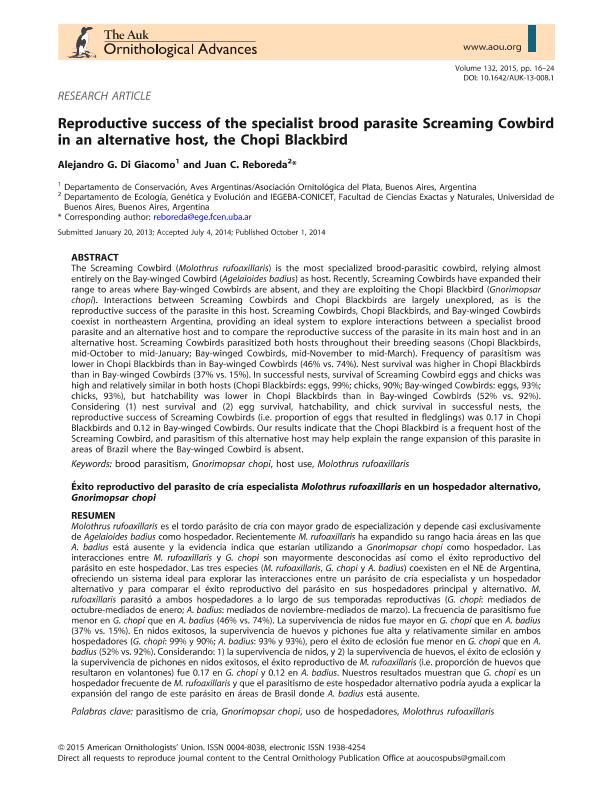Artículo
The Screaming Cowbird (Molothrus rufoaxillaris) is the most specialized brood-parasitic cowbird, relying almost entirely on the Bay-winged Cowbird (Agelaioides badius) as host. Recently, Screaming Cowbirds have expanded their range to areas where Bay-winged Cowbirds are absent, and they are exploiting the Chopi Blackbird (Gnorimopsar chopi). Interactions between Screaming Cowbirds and Chopi Blackbirds are largely unexplored, as is the reproductive success of the parasite in this host. Screaming Cowbirds, Chopi Blackbirds, and Bay-winged Cowbirds coexist in northeastern Argentina, providing an ideal system to explore interactions between a specialist brood parasite and an alternative host and to compare the reproductive success of the parasite in its main host and in an alternative host. Screaming Cowbirds parasitized both hosts throughout their breeding seasons (Chopi Blackbirds, mid-October to mid-January; Bay-winged Cowbirds, mid-November to mid-March). Frequency of parasitism was lower in Chopi Blackbirds than in Bay-winged Cowbirds (46% vs. 74%). Nest survival was higher in Chopi Blackbirds than in Bay-winged Cowbirds (37% vs. 15%). In successful nests, survival of Screaming Cowbird eggs and chicks was high and relatively similar in both hosts (Chopi Blackbirds: eggs, 99%; chicks, 90%; Bay-winged Cowbirds: eggs, 93%; chicks, 93%), but hatchability was lower in Chopi Blackbirds than in Bay-winged Cowbirds (52% vs. 92%). Considering (1) nest survival and (2) egg survival, hatchability, and chick survival in successful nests, the reproductive success of Screaming Cowbirds (i.e. proportion of eggs that resulted in fledglings) was 0.17 in Chopi Blackbirds and 0.12 in Bay-winged Cowbirds. Our results indicate that the Chopi Blackbird is a frequent host of the Screaming Cowbird, and parasitism of this alternative host may help explain the range expansion of this parasite in areas of Brazil where the Bay-winged Cowbird is absent. Molothrus rufoaxillaris es el tordo parásito de cría con mayor grado de especialización y depende casi exclusivamente de Agelaioides badius como hospedador. Recientemente M. rufoaxillaris ha expandido su rango hacia áreas en las que A. badius está ausente y la evidencia indica que estarían utilizando a Gnorimopsar chopi como hospedador. Las interacciones entre M. rufoaxillaris y G. chopi son mayormente desconocidas así como el éxito reproductivo del parásito en este hospedador. Las tres especies (M. rufoaxillaris, G. chopi y A. badius) coexisten en el NE de Argentina, ofreciendo un sistema ideal para explorar las interacciones entre un parásito de cría especialista y un hospedador alternativo y para comparar el éxito reproductivo del parásito en sus hospedadores principal y alternativo. M. rufoaxillaris parasitó a ambos hospedadores a lo largo de sus temporadas reproductivas (G. chopi: mediados de octubre-mediados de enero; A. badius: mediados de noviembre-mediados de marzo). La frecuencia de parasitismo fue menor en G. chopi que en A. badius (46% vs. 74%). La supervivencia de nidos fue mayor en G. chopi que en A. badius (37% vs. 15%). En nidos exitosos, la supervivencia de huevos y pichones fue alta y relativamente similar en ambos hospedadores (G. chopi: 99% y 90%; A. badius: 93% y 93%), pero el éxito de eclosión fue menor en G. chopi que en A. badius (52% vs. 92%). Considerando: 1) la supervivencia de nidos, y 2) la supervivencia de huevos, el éxito de eclosión y la supervivencia de pichones en nidos exitosos, el éxito reproductivo de M. rufoaxillaris (i.e. proporción de huevos que resultaron en volantones) fue 0.17 en G. chopi y 0.12 en A. badius. Nuestros resultados muestran que G. chopi es un hospedador frecuente de M. rufoaxillaris y que el parasitismo de este hospedador alternativo podría ayuda a explicar la expansión del rango de este parásito en áreas de Brasil donde A. badius está ausente.
Reproductive success of the specialist brood parasite Screaming Cowbird in an alternative host, the Chopi Blackbird
Título:
Éxito reproductivo del parasito de cría especialista Molothrus rufoaxillaris en un hospedador alternativo, Gnorimopsar chopi
Fecha de publicación:
10/2014
Editorial:
American Ornithologists' Union
Revista:
Auk
ISSN:
0004-8038
e-ISSN:
1938-4254
Idioma:
Inglés
Tipo de recurso:
Artículo publicado
Clasificación temática:
Resumen
Palabras clave:
Brood Parasitism
,
Gnorimopsar Chopi
,
Molothrus Rufoaxillaris
,
Host Use
Archivos asociados
Licencia
Identificadores
Colecciones
Articulos(IEGEBA)
Articulos de INSTITUTO DE ECOLOGIA, GENETICA Y EVOLUCION DE BS. AS
Articulos de INSTITUTO DE ECOLOGIA, GENETICA Y EVOLUCION DE BS. AS
Citación
Di Giacomo, Alejandro G.; Reboreda, Juan Carlos; Reproductive success of the specialist brood parasite Screaming Cowbird in an alternative host, the Chopi Blackbird; American Ornithologists' Union; Auk; 132; 1; 10-2014; 16-24
Compartir
Altmétricas




